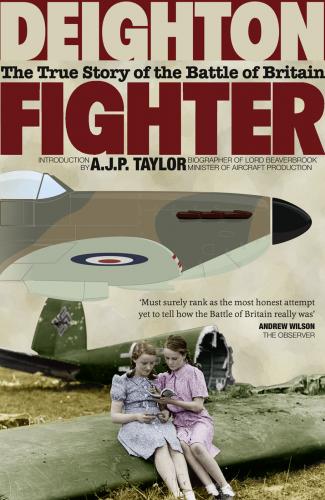Fighter
The True Story of the Battle of Britain
LEN DEIGHTON
CONTENTS
Cover Designer’s Note
Illustrations
Preface to the 2014 Edition
Introduction by A. J. P. Taylor
PART ONE Strategy
PART TWO Air Chief Marshal Sir Hugh Dowding, Commander in Chief Fighter Command
PART THREE Weapons: The Metal Monoplane and Radar
PART FOUR Tactics
PART FIVE The Results
Acknowledgements
Selected Bibliography
Index
About the Author
Also By Len Deighton
About the Publisher
The story of the Second World War is one of tremendous technological change combined with great human emotion. When I set out to design the covers for this reissue of Len Deighton’s trilogy of Second World War histories, Fighter, Blitzkrieg and Blood, Tears and Folly, I wanted to incorporate both of these elements into a unified design theme that could be used on all three books. The books were among the first to offer a balanced narrative of the war with both sides of the story being represented, and I felt it was essential that the cover designs were similarly complete.
To convey the concept of technological change and development I created illustrations that begin as a set of plans on the back cover and continue across the spine to become a full-colour image of a fighting machine on the front. Many things we take for granted today, such as the mobile phone, microwave and air-traffic control, owe their development to the innovation that took place during the war.
The Second World War affected the lives of every man, woman and child living in Western Europe between 1939 and 1945. Television news has made us accustomed to watching remotely piloted drones waging war from the safety of our living room sofas, uninvolved except for the opinions we choose to express. In contrast I felt it was important to remind readers of the direct participation and sacrifice made by everyone during the war, so I carefully chose photographs of women in a variety of roles.
One such woman was my grandmother, an audacious and inspirational person who left her job as a chef to become a skilled oxyacetylene welder making flame traps for night-fighters. Thousands of women like her, building airplanes, tanks and ships, were immortalized in America by the ‘Rosie the Riveter’ campaign. Britain’s survival during the leanest days of the war owes a debt of gratitude to the Women’s Land Army. These hard-working women succeeded in cultivating every available square foot of land and saved the country from starvation when the U-boat campaign was at its most successful.
The extraordinary women of the First Aid Nursing Yeomanry created a secret unit that was dropped by parachute behind enemy lines to undertake espionage work for the Special Operations Executive. Bletchley Park’s work in cracking the ‘Enigma’ codes is well known, and many of the brilliant code-breakers were women. The magnificent women ferry-pilots of the Air Transport Auxiliary flew everything from fast and nimble Spitfire fighters to large and powerful Lancaster heavy bombers, many with battle damage and in need of repair. The Royal Air Force and Royal Navy depended on an army of women radar controllers to manage their operations in the air and at sea.
The contribution to the war made by women was not limited to Britain. In America Jacqueline Cochrane’s famous Women’s Airforce Service Pilots ferried military aircraft, while flight nurses – the unsung heroines of the US Army – provided critical medical attention to wounded soldiers, saving lives on both the European and Pacific fighting fronts. In Russia, too, all the Red Army’s nurses were women. Those serving as front-line medics were also armed and expected to fight alongside their male comrades when not attending to the wounded. Their casualty rate was approximately equal to that of the Red Army infantry. These women demonstrated that they were every bit as willing to help win a war against an enemy that threatened the life they knew. Together they blazed a trail for equality and their lasting contribution to today’s society deserves to be recognized.
Fighter: The True Story of the Battle of Britain tells the story of Germany’s attempt to gain control of the air above Britain in preparation for invasion. Technological advances in aircraft design, radar and planning played an important role in the Battle’s final outcome. Although the Hawker Hurricane bore the brunt of the fighting, Mitchell’s superb Spitfire was the more technically advanced aircraft with its all-metal construction and monocoque fuselage. The rapid pace of aircraft development at that time is represented by a Spitfire Mark IIA, serial number P7350. Beginning as a set of line-drawn plans on the back cover, it becomes a full-colour illustration on the front cover; its brown and green upper surfaces and pale underside having become an emblematic symbol of the Battle. Wearing the squadron codes UO-T, Spitfire P7350 was assigned to 603 Squadron based at RAF Hornchurch in October 1940. A genuine Battle of Britain participant, she survived the war and still flies today as part of the Battle of Britain Memorial Flight. The front-cover photograph is a period-correct image that immediately tells the story of the Battle through the eyes of the civilian population. The two schoolgirls sitting on the wing of a crashed Heinkel He 111 clearly convey the threat of German bombing with the everyday stoicism of the children who were innocent participants.
Antoni Deighton, 2013
2 June 1940 – Hitler Rules Europe
10 Supermarine Spitfire F.7/30
13
